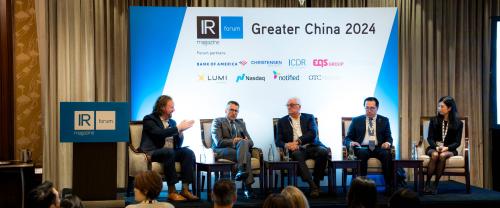Victoria Hyde-Dunn, head of IR at 8x8, moved from Visa to the small-cap cloud communications firm in 2017. Here she talks about what it’s like to have worked across a range of companies, in terms of what they do, how their cap size impacts IR and their ability to attract sell-side coverage – a theme she’ll be discussing at the IR Magazine Think Tank – West Coast II in September.
Click here for more information on the think tank or to book your place.
The issue of reduced coverage was being discussed even before Mifid II was introduced in Europe at the start of 2018. How have you responded to these changes?
I implemented a robust investor marketing program, which has led to an increase in sell-side coverage. My company and other small and mid-cap companies in the US have not yet seen large impacts from Mifid II. But small and mid-cap companies in Europe continue to see a reduction in sell-side coverage and reduction in research quality. This is not surprising given reductions in research spend.
As a result of Mifid II, the issue of equity research – across everything from coverage numbers and quality to the idea of a ‘juniorization’ of research – is much discussed among European IROs. Do you think the issue is as pronounced in the US, and do you think US IROs are as prepared as they should be for these changes?
Based on conversations with US IROs, there is a sense that Mifid II/the unbundling of services will occur in the US but the expected timing is unknown as the SEC has until July 2020 to review all possible outcomes.
The majority of US IROs are not proactively implementing changes to their daily IR routines and approach to engagement, and sentiment suggests there is value in the depth of coverage US sell-side analysts provide to the overall ecosystem as well as to asset managers, retail investors and small companies in the capital markets.
What positives do you see coming out of this situation?
One school of thought is that bulge-bracket firms and boutiques could benefit because they offer a differentiated approach to conferences – such as two or three-day events across all market caps and industries – and research (more in-depth research that is thought leadership-oriented), coupled with investment banking activities: M&A, convertible debt, share buybacks, and so on.
Many others believe a common set of ‘rules’ for EU and US engagement will create a level playing field and provide additional expense and data transparency.
As the sell side has evolved in recent years, have you spent more time reaching out directly to international investors or arranging meetings yourself?
I believe the sell side remains the best way for US corporations to engage with the right European investors. It is important for IROs to be efficient with international roadshow schedules and use of management’s time.
Local knowledge from the sell side is imperative and its sole focus is to communicate with the buy side every day. I do find the sell side’s expertise and targeting recommendations to be valuable.
Corporate access firms are also arranging meetings with non-clients, which helps optimize IR and corporate access interests.
Do you see the buy side increasingly reaching out to you?
I have observed a subtle change, particularly with large European fund managers bypassing the sell side or corporate access teams and going direct. The majority of European buy-side firms I meet with will continue to use corporate access, especially for bus-tours and multi-city events. By going direct with a small group, the buy side has greater control of the meeting process and its timeline.
I am also seeing increasing interest in technology, especially in videoconference meetings, which – interestingly – is a service 8x8 offers.
Finally, having spent much of your career at large and mega-cap companies before joining small cap 8x8, what difference do you think cap size makes in all this and what can small-cap IROs do to improve coverage – in terms of both numbers and quality?
Sell-side research and corporate access generates interest in your corporate story. This allows valuable access to asset managers that otherwise may not have been on your radar.
There are built-in advantages to being a large-cap or a mega-cap company. But a recognizable global brand, strong earnings results and street credibility can outweigh a short-term lack of coverage. We took several approaches to increase quality coverage and raise the firm’s visibility from 10 to 15 sell-side analysts in the past 18 months.
These included:
– Proactively seeking out sell-side analysts who cover our sector or peer universe, including firms that have multiple-analyst coverage. This might depend on your sector: I have seen this trend in technology and adjacent sectors
– Reaching out to secondary analysts – not just the primary – as many of the larger firms are reallocating coverage to smart ‘junior’ analysts
– Reaching out to former sell-side analysts who have covered your previous firm. They can help serve as a credible recommendation with the potential new analyst. Similarly with corporate access, these contacts can be a valuable resource to help move the analyst
– Outspoken buy-side shareholders that love your story and think you are undervalued can lend support.










